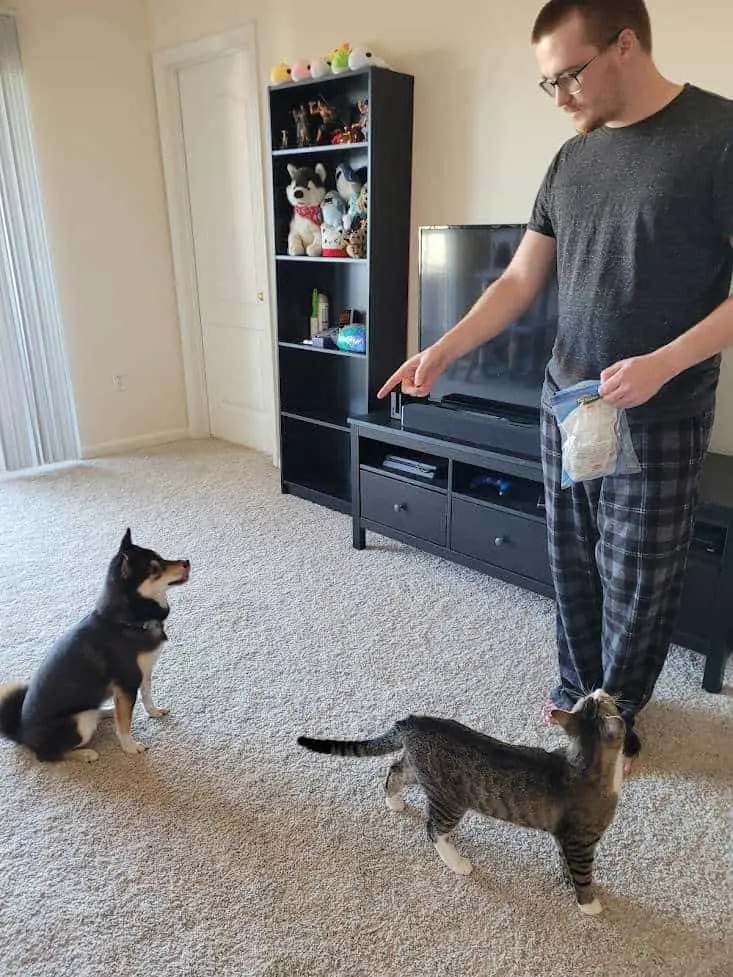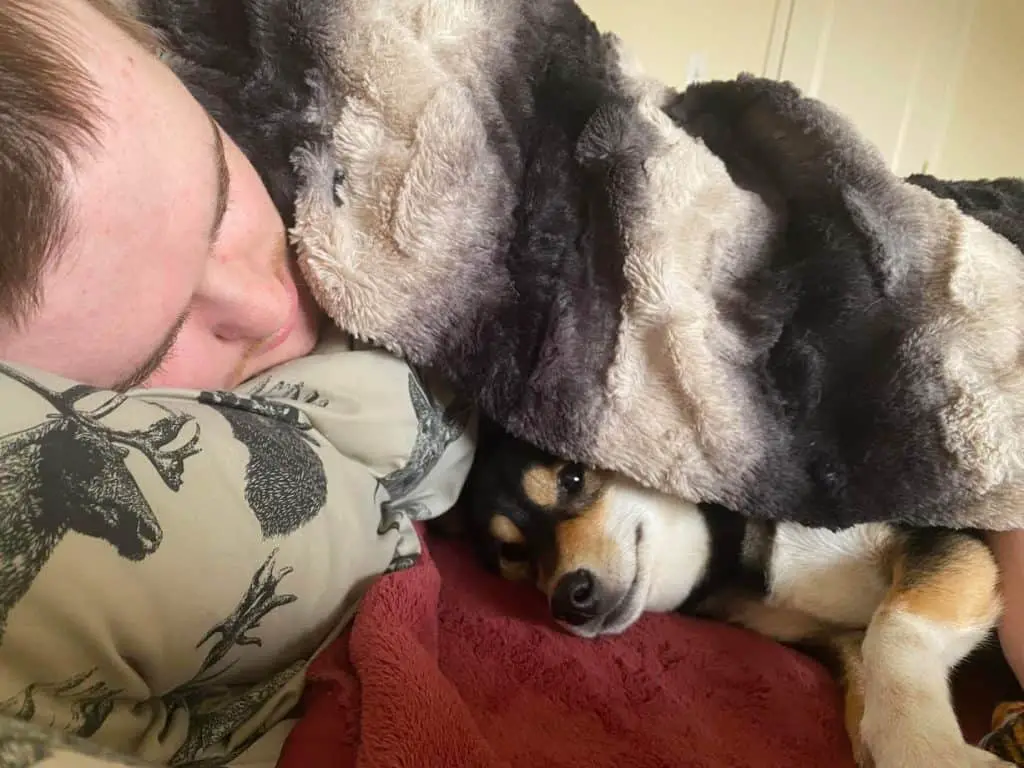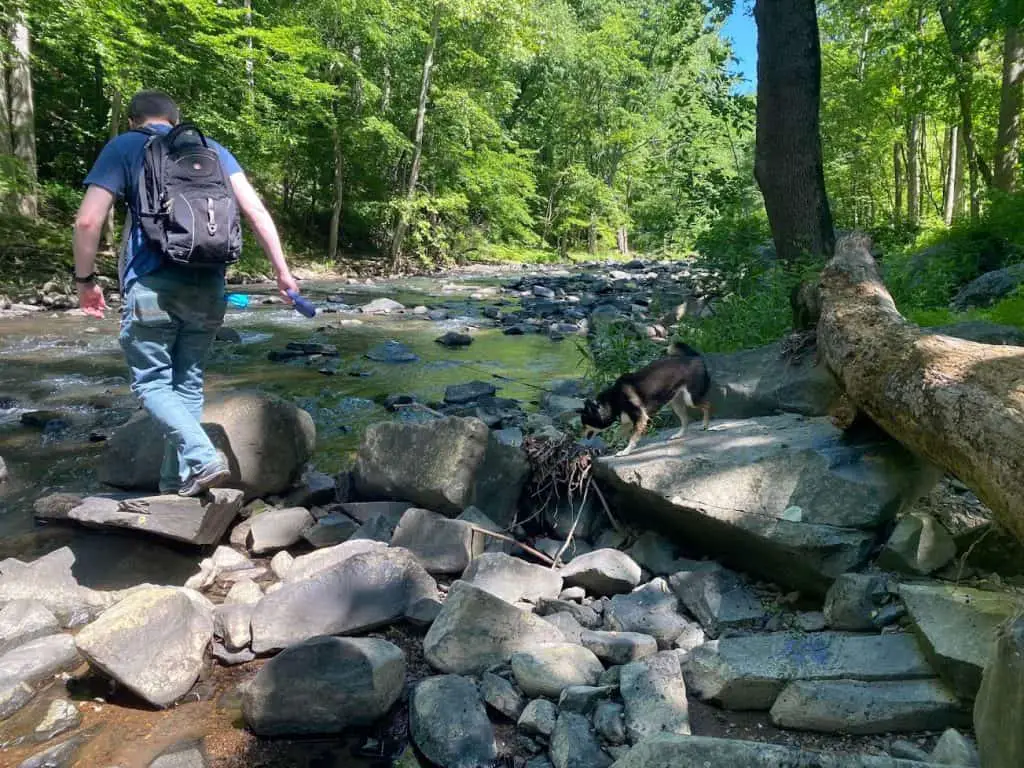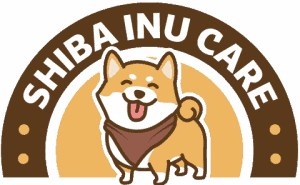This post contains affiliate links.
I’ve had family pets my whole life but Faith, my Shiba Inu, was my first personal pet. Meaning I had a lot to learn when it came to proper training and discipline. Thankfully it wasn’t as bad as most people say.
Shiba Inus are one of the most difficult and frustrating breeds to train due to their stubborn nature, aloof personality, and self-centered attitude. For the best results you should stay calm, stick to a schedule, be consistent in your corrections, and reward them for behaviors you’d like repeated.

Breaking down and understanding that personality was key, right next to taking the time to make a proper training schedule. Everything I’ve learned so far is shared below.
Why Training Shiba Inus Is Such A Challenge
Shiba Inus are a high-energy, stubborn, independent, dominant, free spirited breed that has many cat-like qualities. It’s common for your Shiba to look at you after a command and walk away. These dogs have a mind of their own and won’t listen unless they think it’ll benefit them.
That strong personality of theirs makes training difficult.
For the best results you want to stay calm, even if you get frustrated. While stubborn, Shibas are smart and pick up on people’s emotions. If you are getting stressed out and agitated your pet will feed off that,becoming stressed and agitated themselves.
The vast majority of problems Shiba Inu owners run into are social and aggression based. Shibas were bred to be independent hunters, leading to a lack of social understanding. Stress pushes these dogs towards aggression, taking the time to introduce them to other pets, people, sights, sounds, and environments minimizes the odds of them lashing out.
Their natural pull towards dominance, and headstrong personality, results in aggression. Territorial, food-based, possession, social, and predatory being the main types. Patience and regular socializing minimizes that aggression. It also reduces stress and leads to a happier pet.
This breed is not easy to train, especially if you are ill prepared to handle their gambit of negative personality traits. With that said, training a Shiba Inu is entirely possible for anyone. You have to build a routine, stick to a schedule, and be consistent. Shibas thrive on routines and will remember when you’ve been lenient.
If you are thinking about getting a Shiba Inu as a first pet I recommend you don’t underestimate them. These dogs are incredibly smart. If you don’t learn how to control and train them, you’ll be the one receiving training. Build out a training schedule before thinking about getting one.
Here are some common pitfalls Shiba Inu owners run into.
How To Train Your Shiba Inu
While difficult, and at times frustrating, training a Shiba Inu is actually fairly straight forward. The steps and actions you want to take are simple, but are not always easy. There are multiple steps and phases involved in successfully training a dog. I personally have had success with the following:
Set Ground Rules From Day One
The best relationships have foundational rules. In order to minimize bad behavior you want to set some for your Shiba Inu. 3 Easy rules to start with are:
- No biting
- No resource guarding
- No roughhousing
These rules focus on minimizing aggression. While you may understand your Shiba’s quarks, others people and children may not. This breed has sharp teeth that cut like a pair of scissors, they’ll easily cause bleeding when they get serious.
Build A Bond With Your Shiba Inu
While Shiba Inus are loyal and friendly dogs, they usually bond to one person. That vital bond with their owner is slow to build but lasts a lifetime. Problem is, it’s easy to break and nearly impossible to recover once broken.

The best way to build that bond is by spending genuine time with them.
Every Shiba Inu is different. Some love meeting people, others like being in a quiet room, some love hikes, while a few may prefer swimming. Learning the things they like, dislike, and making adjustments as time passes shows them you care.
Figure out what rewards they like best and leverage that knowledge during training. These dogs are smart and sincerely appreciate the time they spend with you.
Avoid Common Mistakes Shiba Inu Owners Make
With how habit dependent this breed can be missing the little things becomes a massive problem down the line. My advice to anyone currently with, or looking at getting, a Shiba Inu is the following.
- Start training early – It’s never too early to begin training. The sooner you get started the less bad ingrained habits you’ll be fighting against. Puppies at 8 weeks old are able to learn more than you’d think.
- Avoid fighting aggression with aggression – Yelling and hitting your pet teaches them it’s perfectly normal to fight violence with more violence. You want to minimize their aggressive tendencies and maximize their happiness whenever possible.
- Don’t underestimate what proper socializing can do – Spending time to regularly socialize your Shiba Inu gives them the tools and skills they need to handle complex situations. That familiarity reduces stress and ultimately reduces the odds of them turning to aggressive behaviors.
- Get them used to being handled – The biggest part of social interactions is that “interactions” part. Get your Shiba used to being pet, picked up, ears touched, tail uncurled, paws held, and neck massaged. That comfort in being touched makes grooming and traveling with them easy.
- Physically and mentally work them out – Shiba Inus are full of energy, highly alert, and get bored easily. Failing to get enough physical exercise actually stresses them out. And a great way to keep them from chewing on your furniture is by giving them a puzzle to solve.
- They’re like an overbearing 2 year old, don’t let them win – Shiba Inus are naturally dominant, owners who fail to take control are trained instead.
- Don’t punish every mistake they make – Accidents happen and everyone learns at their own pace. If you stumble upon an old accident, just clean it, dog’s memories are associative. Meaning if it didn’t happen 5 seconds ago, they won’t understand.
- Know they may never fully respond to a command – These cat-like dogs do what they think is best for them. If they don’t think walking over to you will get them what they want at that moment, you’ll be ignored. Just like a cat.
- Never trust a Shiba Inu off leash – Shiba Inus were bred to be independent hunting companions. Meaning the moment they spot something they’re gone. And unfortunately they see you calling and chasing after them as a game.
Proper Discipline Makes All The Difference
There are two forms of discipline, positive and negative reinforcement.
Positive reinforcement revolves around praising and rewarding behaviors you want your Shiba Inu to repeat while ignoring ones you dislike. This is by far the best way to train and discipline your pet, especially if you want to keep any bond you’ve started to build.
Negative reinforcement consistent terrible behaviors such as: Yelling, hitting, kicking, refusing to reward good behavior, rubbing your pet’s nose in an accident, and excessively long timeouts. This method of discipline shatters any bond you had with your pet and actively trains them to be aggressive.
It may be hard at first but do your best to be positive, calm, and fair in both your expectations and corrections. You can learn more about how to properly discipline your Shiba Inu here.
Validate Your Training Sessions
Shiba Inus have the fun combination of being very alert yet get bored easily. Distractions while training, especially when starting something new, are a big problem. Which is why it’s recommended you begin all of your training sessions in a controlled environment.

That being said, nothing is perfect in the real world. Cars drive by, people walk past you, and other pets may be walking around. All of which are distractions.
After your Shiba has consistently demonstrated they understand a command, like sit, it’s time to increase the difficulty. Take that controlled training session outside. Some people call this process “proofing”.
Our goal here is to verify that even though there are distractions our pet is paying attention and actively listening for our commands. An example of this could be the “sit” command.
When I started teaching Faith to sit on command, things were a bit slow. She struggles with over-excitement and is constantly looking to play. Both are exaggerated when we’re outside. But once she started to get the hang of it around the house I wanted to make sure she’d do the same while on a walk.
As a puppy, I always had her sit before we crossed the street. For the first few days, she was overwhelmed by the other people, pets, and cars passing by. But she gradually got used to it. After a few weeks, she had zero issues coming to a complete stop and sitting on command.
That extra step, especially for “sit”, has helped when other people walk by, want to meet her, or have an overexcited pet they’re struggling to control.
Taking that extra step to validate her indoor training works outdoors is a critical step pet owners should take, especially with this breed. Make sure you do this for everything you teach your Shiba Inu. Those tests in a distracting outdoor environment double as testing for a busy indoor one.
There Are No Shortcuts
All things worth doing take time, effort, and consistency. The key to success isn’t to rush through things, it’s to take things slow and train your Shiba Inu right the first time.
Everybody learns at their own pace, and dogs are no different, take the extra second to see how they are keeping up.
- Do I have my Shiba’s full attention?
- Do they understand what I’m asking?
- What is my Shiba Inu constantly messing up?
- Would slowing down and guiding them help?
It’s important to ask yourself the questions above.
Another thing you should know about this breed is how their stubborn independence plays into their training. There is no guarantee, even after regular training, your Shiba Inu will even listen to you.
It’s normal for your Shiba to look over just to turn around and walk away, this breed is very cat-like. They get bored easily and selectively hear the things that get them what they want.
Bonding and regular training can minimize that, but there is no 100% guarantee. That free and independent spirit is the reason Shiba Inus can’t be trusted off-leash.
Summary
While not easy, training your Shiba Inu is fairly simple. Build a schedule, stick to a routine, be fair and honest in your corrections, stay calm even when frustrated, and most importantly be patient.
There is no miracle cure or quick fix when it comes to correcting bad behavior or teaching your Shiba a new command. These things take time, so take an extra moment to do things right the first time.
I’ve shared the most common questions people have asked me below. I hope they’re as helpful for you as they have been for others.
Frequently Asked Questions
Are Shiba Easy To Train?
There are many dog breeds that are difficult to train, and the Shiba Inu is one of them. Most first time Shiba Inu owners fall for their cute “fox” like appearance and fail to take their stubborn domineering personality into account. It’s best to train them using schedules and routines.
Are Shiba Hard To Train?
Shiba Inus are considered one of the more difficult dog breeds to train. Shibas are high energy, alert, stubborn, and strong willed. All of which make training them a real chore for those unwilling to take control. Find out what your Shiba’s favorite treat is and stick to a schedule.
Are Shiba Inus Easy To House Train?
Shiba Inus are naturally clean and tidy, just like cats. Most puppies are easily housebroken on the first day or during that first week, but not all. It’s best to follow a consistent potty schedule, and increase the time between bathroom breaks as they age.
Can Shibas Be Off Leash?
Shiba Inus have a high prey drive, lots of energy, are free-spirited, and love to play. Leading to most Shibas running away once off leash. Unfortunately, chasing after them in a panic and calling their name looks like play to them, so it’s best not to let them off leash. Unless in an enclosed area.
How Do You Deal With A Stubborn Shiba Inu?
While stubborn, Shiba Inus can be swayed with the right kind of motivation. If your Shiba is ignoring you or misbehaving it’s best to bring them to a quiet, distraction-free place. Reward their good behavior with a treat or quick play session while withdrawing your attention when they act out.
How Do You Train A Shiba Inu To Come When Called?
The most consistent way to get your Shiba Inu to come when called is by getting them moving first. Shibas are full of energy and love to play, running around or tossing a toy work. Next, make sure their reward is worth the effort. A simple treat or quick play session are fan favorites.
